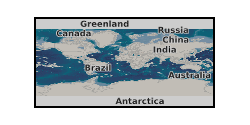Earth core
Type of resources
Topics
Keywords
Contact for the resource
Provided by
Years
Formats
Update frequencies
-

This dataset contains VASP runs performed on several supercomputing services (ARCHER, Monsoon, Thomas and Grace in the UK; Eos in the USA) to calculate the chemical potentials of liquid iron mixtures and solid ferropericlase at Earth's core conditions using density functional theory. Data are available for the chemical potentials of iron in MgFeO and oxygen in liquid FeSiO. These data were used to calculate the partitioning of oxygen between ferropericlase and Earth's liquid core and to analyse the chemical boundary layer above the CMB. The present grant also supported work regarding the homogeneous solid nucleation in iron and iron-oxygen mixtures at Earth's core conditions when dealing with the core paradox. Classical nucleation theory data and results from VASP runs and classical molecular dynamics runs performed on ARCHER and Eos (Oak Ridge, USA) are also included in the uploaded dataset. In addition, the present grant also supported research on the dynamics and evolution of the Earth's core, together with a study confirming the saturation of electrical resistivity of solid iron at Earth’s core conditions (these data were uploaded as part of a previous NERC Grant, NE/H02462X/1). Further details can be found in Davies, Pozzo and Alfe’ (2018, in press); Davies et al. (2018); Pozzo and Alfe’ (2016); Davies et al. (2015).
-

The two-phase modeling of water between liquid iron and silicate melt at 50 and 135 gigapascals (corresponding to 3500 and 4200 kelvin) was performed by using ab initio molecular dynamics implemented in the Vienna Ab Initio Simulation Package.
-

This collection includes the elastic calculations of the hcp-Fe-Si-S-C alloy system. NERC grant NE/M015181/1 - Pre melting in iron and iron alloys: ab initio calculations and high P-T experiments on iron, iron alloys and other materials
-

This dataset contains VASP runs performed on ARCHER to calculate the electrical and thermal conductivities of pure iron and iron alloys at Earth's core conditions using density functional theory with the Kubo-Greenwood formulation. Data are available for both the solid and the liquid phase characterising the inner and outer core respectively. Also included in the dataset the runs for computing the lattice contribution to the electrical resistivity of magnetic bcc iron at ambient pressure and two low temperatures and for computing the melting curve of fcc nickel. These data were also used for the modelling of the geodynamo and the thermal history of the Earth, to calculate the transport properties for silicon-oxygen-iron mixtures and to confirm the saturation of electrical resistivity of solid iron at Earth’s core conditions. The results from this dataset showed that both conductivities are much larger than previously thought with important implications for the geodynamo and the thermal history of the Earth, benefitting the geodynamo community. The results of our research have been recently confirmed by new experimental results obtained at Earth's core conditions. Further details can be found in Alfè et al. (2012); Pozzo et al. (2012, 2013a, 2013b, 2014, 2016); Gubbins et al. (2015); Davies et al. (2015). NERC Grant is NE/H02462X/1.
-

In this urgency proposal we will deploy seismometers for 1 year to record aftershocks from sequence of 4 major earthquakes with magnitudes between 7.1-7.6. These recordings and other recordings of earthquakes from around the globe will allow us to delineate with high accuracy the plate interfaces of the new and old subducting slabs and image the slab structures at depth. The structure of the old and new subduction zones will illuminate the processes occurring at depth which are shifting the force balance in the region to reverse the sense of subduction. The proposed experiment will be enhanced by concurrent studies scheduled to be deployed in Fall of 2014, which includes a multimillion pound ocean bottom seismic deployment by colleagues in Japan. The combined array will allow us to image the Pacific plate which is stalling the subduction, allowing us to investigate what conditions are necessary for a plate to halt the descent of the slab into the mantle. Thus we will be able to understand how subduction stops and starts. Data available online at the Incorporated Research Institutions for Seismology (IRIS) Data Management Centre (DMC).
-

This project is aimed at understanding what kind of conditions the Earth's core formed under and how this affected the amount of oxygen present in the rocky interior of the Earth. It uses experiments which simulate the very high pressures and temperatures that would have been present in the Earth's interior when the core formed, combined with very precise chemical analyses of these experiments. From these results I will learn how certain chemical elements distributed themselves between the metal core and the rocky outer part of the Earth, and whether this distribution behaviour changes with different conditions and with the amount of oxygen present. By comparing the results I get from the experiments with the chemical compositions of rocks from the Earth and very primitive meteorites we will be able to understand better how the Earth's core formed, and how this may have affected the chemistry of our planet and the development of its atmosphere and oceans. Four papers are linked to this grant: Stable chromium isotopic composition of meteorites and metal-silicate experiments: Implications for fractionation during core formation Unlocking the zinc isotope systematics of iron meteorites Iron isotope tracing of mantle heterogeneity within the source regions of oceanic basalts Isotopic evidence for internal oxidation of the Earth's mantle during accretion
 NERC Data Catalogue Service
NERC Data Catalogue Service